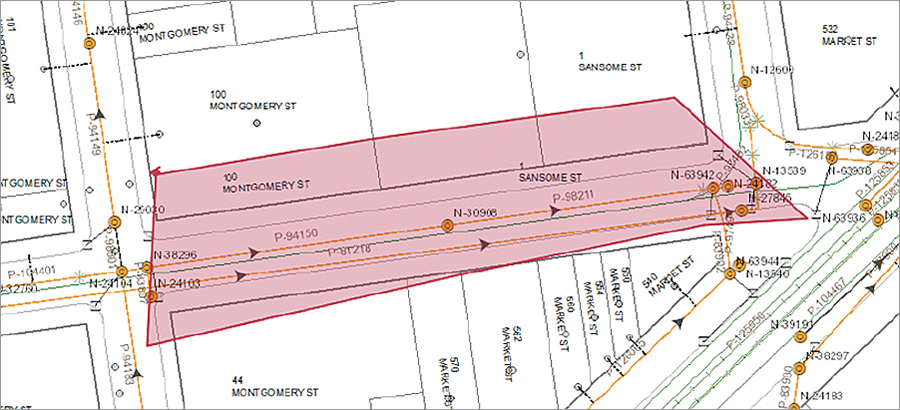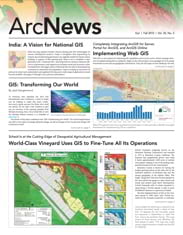For the San Francisco Public Utilities Commission, Benefits Abound
Situated on the Northern California coastline, San Francisco is consistently among the top tourist destinations in the world. Rich in history and culture, the “City by the Bay” is home to iconic landmarks, such as the Golden Gate Bridge, cable cars, Alcatraz, Fisherman’s Wharf, and the famed Chinatown district. The city also is known for its striking architecture and notably steep, rolling hills.
The hilly terrain that so readily defines the city also poses special challenges for area utilities, such as the San Francisco Public Utilities Commission (SFPUC). Rain events can produce flooding so significant that SFPUC can generate up to 100 service requests/work orders an hour. The question for SFPUC becomes, How do we mitigate these calls and deploy staff quickly to resolve the problem? While the problem simply may be clogged storm water drains, if not handled swiftly, intense flooding threatens to damage nearby homes.

The Challenge at SFPUC
SFPUC Wastewater Enterprise operates and maintains 993 miles of combined sewers, collecting sanitary sewage from homes and businesses and street runoff. It also operates and maintains storage facilities and three sanitary sewage and storm water treatment plants.
The immediate need in SFPUC’s Sewer Operations was to resolve the disconnect that existed between the work order and asset management system and the field service work taking place. As existing users of ArcGIS and IBM Maximo, staff could view asset data in tabular format within the work and asset management system and see assets using ArcGIS but could not view assets and work orders in proximity to each other.
The existing process was tedious and time-consuming. Sewer Operations received service calls based on address/service locations. Calls were converted into work orders and assigned to field personnel on 3 x 5 cards. Work orders were then assigned manually to assets by looking up asset IDs in GIS and copying the information into work orders.
“We had two islands of information that were not connected,” says Lewis Harrison, manager, SFPUC’s Wastewater Collection System Division. “There was a synergy there just waiting to happen.”
SFPUC sought to integrate its existing GIS with IBM Maximo Spatial Asset Management to resolve workflow issues and help address other challenges, including the following:
- Odor issues—Visualizing on a map to better understand and solve calls relating to odor issues
- Intersection flooding—Responding quickly and efficiently to emergencies caused by heavy rains and identifying hot spots using GIS, asset data, and location data from incoming calls
- Duplicate work orders—Eliminating multiple work orders opened on the same service issue
- Asset data—Identifying key assets in the sewer system
- Access to data in the field—Reducing time and travel to obtain asset information and perform service
- Formalized asset management program—Developing a program to better understand asset condition and life cycle costs

Esri Silver Tier Partner EMA, Inc. (St. Paul, Minnesota), was selected to help the utility with the implementation. EMA’s experience with GIS, asset management, and technology integrations supported SFPUC’s goal to create tools that would enable service calls and assets to be viewed geospatially.
“Our work order history needed to be visible on the map,” Harrison says. “Integration of our data and systems was key.”
The Project
The project team identified the functional requirements of the integration and designed and developed solutions during the project’s pilot phase. Implementation in Sewer Operations included a workflow gap analysis, configuration with the work and asset management system and geodatabases, data loading, synchronization, and testing.
ArcGIS Interaction with Spatial
Using an ArcGIS API for JavaScript technology platform, maps were embedded inside Maximo screens, allowing users to interact and perform common GIS tasks and to access and view their data on actual maps.
Integrating GIS and Asset Database
GIS data resides outside the asset database in a separate geodatabase. GIS feature classes are registered as objects in the asset database, keeping the data separate but available for use in all systems. GIS attribute data would be fully accessible via the geodatabase interface, which would use an Esri SQL API to integrate the database. The direct link between the geodatabases would eliminate any need to replicate data.
Key aspects of the implementation included the following:
- Redefining/Recasting assets to address existing data errors
- Securing GIS data steward services with another city department to ensure timely data updating
- Training both before and after launch that encouraged active participation and feedback, kept everyone informed, and supported the project’s success
- Integrating with San Francisco’s 311 (citywide 24-hour customer service center) to leverage the citizen service request and dispatch system
Benefits
The new functionality brought monumental improvements to the wastewater enterprise. The project improved the planning, scheduling, and dispatching of work in Sewer Operations by enabling staff to see what work is being done and where. Staff can cluster incoming service calls to identify problem areas to deploy crews rapidly, particularly during storm events.
“In the past, we were not concerned about the type of equipment that responded to a site but just that someone was responding,” Harrison explains. “Now we’re looking at our screens, understanding more about a problem, and determining what kind of equipment to send.”
Workflow improvements have eliminated multiple work orders for a service issue and reduced the dispatching of multiple service crews to the same site. At the same time, asset management tools are efficiently tracking and planning maintenance work.
“The increased knowledge we have on the state of our assets helps us with our maintenance, repair, and replacement decisions,” Harrison says.
ArcGIS query capabilities can be performed within the work and asset management system, and asset data and location data is up-to-date—even for those in the field.
“Data quality has improved dramatically,” says Lily Dryden, enterprise GIS coordinator at SFPUC. “Field service crews redline errors in the field and send them to our GIS data steward via the work order. Updates are seen within a day, so our knowledge on field conditions is reflected on our GIS maps.”
For more information, contact Lily Dryden, enterprise GIS coordinator, San Francisco Public Utilities Commission, or Dave DiSera, vice president and IT practice director, EMA, Inc..

